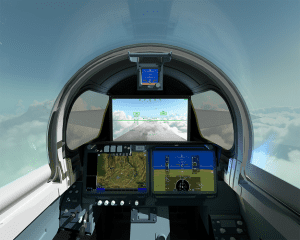This post is also available in:
 עברית (Hebrew)
עברית (Hebrew)
NASA has been at work developing an experimental plane that can fly faster than the speed of sound without a windshield. If all goes according to plan, by 2021 the experimental jet will be test flown.
Instead of having a windshield, the jet will sport two cameras recording the outside view from the jet. The video recorded will then be projected in real time on a 4K monitor, that will act as the jet’s windshield.
The aircraft is called the X-59. Developed by NASA and constructed by Lockheed Martin, the X-59 intent is to be able to travel at supersonic speeds without producing a sonic boom. This is so the aircraft would be able to travel at supersonic speeds without disturbing civilians on the ground below.
The reason the X-59 is designed without a windshield is to keep the jet aerodynamic. The X-59 has been designed with a very long nose, nearly 50 feet. This is to eliminate the need of a cockpit canopy sticking out of the jet and interrupting the flow of air around the jet. If it were possible to make the jet’s nose out of durable transparent material then there would be no need for cameras and monitors, but so far that technology doesn’t exist yet.
So using high definition camera on the X-59’s nose and another underneath the nose will provide an alternative to the traditional windshield. The bottom camera will be intended mainly for landing and takeoff. When the jet is traveling at supersonic speeds the camera retracts into the jet, similar to landing gear, in order to lower drag.

One issue involving a camera-monitor windshield is the issue of latency, the time difference between images being picked up by the camera and displayed on the monitor. NASA intends to keep the latency under one tenth of a second to avoid pilots getting motion sickness. As of now, the system has a latency of .067 seconds.
Another issue with the X-59 involves the off-chance that the monitor or one of the cameras break or malfunction.
If one camera breaks it is always possible to fly the airplane using the second one. If the monitor breaks, then the jet still has small windows the pilot can see through on the top of jet and on the sides. This could give the pilot enough of a view to land the jet. Using navigation information and heads-up displays, pilots could land without looking straight forward.
Popsci.com mentions that the whole point of the X-59 program is to see if supersonic flight is capable above land, something that many private companies are also studying. Such a discovery would be great for commercial air travel, as well as staying stealthy in military operations.


























